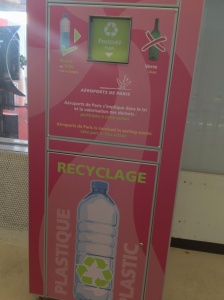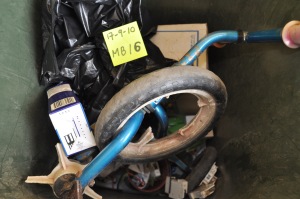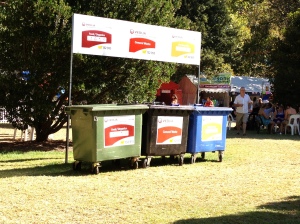Imagine yourself at the airport. You are approaching the security screening on your way to your gate. How do you know when you are getting close? It is not just the men who start taking off belts, shoes and emptying pockets (which I kind of like as it makes up for the fact the queue is always longer at the Ladies), it is also the increasing trail of water bottle sentinels.
Travel takes it out of you, literally (as an aside, I read that ‘literally’ has just been redefined to include use for emphasis rather than meaning ‘in reality’. Here I mean ‘in reality’ for the dehydration caused). I often wonder what happens to all these abandoned half drunk bottles of water. Many appear to just go straight into the bin destined for landfill (have a look in the bin at the screening point next time you pass). Certainly there is no recycling option; until now. On a recent trip through Charles de Gaulle airport I saw this just before the screening point….
Being pink, it stood out. It was also in an area where there were no other dispensing machines or distractions. People were noticing and using it. Why is this better that a simple recycling bin? Well, one reason might be that it avoids contamination with other items. We are not in our best waste sorting behaviour when travelling. It takes the bottles full or empty which is also a plus. I hope to see more of these with time. It seems like such an obvious piece of infrastructure that was missing.
Another interesting initiative was spotted by my husband, Byron. When the toilet roll is finished you can just flush it too. No new behaviour called for! How easy is that. Mind you, the schools that use toilet rolls for craft and the dogs that like to treat them as chew toys might be a bit sad about this development – but I bet these are less than 2% of all rolls that we use… You can read more about it at http://www.aquatube.eu.
Aqua Tube is made with pulp from certified suppliers. This means that the pulp used to make Aqua Tube comes from suppliers who are legally harvesting wood coming from well managed forests. We work with a variety of certification programs such as FSC and PEFC.
There is even a phone app that gives you practice flushing them.
I was thinking this could be a sustainability step forward (maybe it was just the word ‘biodegradable’ that gave me warm furry feelings), so I decided to look more closely at the environmental implications…..
From their web site information, it seems that the environmental impact of flushing is the same as putting your roll in landfill.
Using the methodology that was developed by an external expert group, we conducted a full Lifecycle Analysis. Results confirm that there is no difference with regard to the environmental impact of using products with Aqua Tube compared to products using a traditional cardboard core disposed of with the household rubbish.
So, if you already recycle your rolls you make less of an environmental impact if you continue to do so with Aquatube rolls, rather than flushing them. There is no sustainability improvement in this technology change. In fact the ease of disposal means that people will probably be less likely to bother to recycle the rolls. A step backwards then for sustainability in the bathroom.
I’ve noticed that pseudo-sciencific claims are often used in the selling of products – especially so in the cosmetics and beauty industry. I first noticed this in my 20s when I was at the Estee Lauder counter buying my usual moisturiser. Only this time it looked different. I was told that the new version of my product was much better. Why? Well, because it was “more scientific”. I’ve never forgotten those words and the confidence with which they were said (despite the salesgirl being unable to elaborate on what exactly that meant). While I agree that something that has been scientifically developed should be more efficacious, that claim was just a little to non-specific for me. Travelling back through Asia this week, I found that things are still the same (and I am no longer in my 20s) .

Wow – stems cells, DNA, RNA. What do these claims mean? I searched their website for more information.
A team of scientists and passionate botanic health activists ventured into the rainforest in search of new plants and herbs and discovered a new network of positive energy and healing properties of plants that could benefit mankind. In the pursuit of a lifestyle inspired by the goodness of nature, this team successfully uncovered the secret of plant life and established Kinohimitsu.
Why have we not heard about this discovery of “the secret of plant life” in the headlines of newspapers?
Ok, back to the product. The claims are:
Kinohimitsu J’pan StemCell Drink is the most innovative anti-ageing drink that helps you to look younger and feel fantastic! Kinohimitsu J’pan StemCell Drink contains patented Snow Lotus Stem Cell, DNA, RNA and other active ingredients to rejuvenate and re-energise every cells in our body. With Kinohimitsu J’pan StemCell Drink, ageing can be delayed and quality life can be prolonged naturally!
The ‘evidence’ for this comes from a reported clinical trial amongst 200 men and women in the BIO TECH lab, Japan. But no details are given as to how the supposed skin and body improvements were measured that lead to the conclusion that the product makes you an average of 5.2 years younger! This is my latest example of using vague pseudo-scientific claims to sell a product. I have nothing personally against this company. There are hundreds of other examples I could have chosen, I just happened upon this one.
My point is that, while we all like to buy hope, this is a step too far by the marketers. Consumers need a way to be able to discriminate between product offerings and to assess the veracity of a product’s claims. Trying to baffle people with pseudo science such as this undermines the positive contribution that science generally makes to product performance claims.
Oh and they also make a bust increasing drink……
Going back ten years, most households in Australia had a single ‘rubbish’ bin and, if they were lucky, another bin (or a plastic box in my household’s case) for glass and paper recycling. Today, I have an organics bin, a land fill bin (ie old ‘rubbish’ bin), a recycling bin as well as a kitchen caddy where I collect food scraps that I can place into the organics bin. My landfill bin has shrunk to half its original size while my recycling bin has doubled. This is an effective way of visually encouraging me to use the new bin system choices I have been given and also a means by which to physically limit me from old disposal habits.
As a researcher with an interest in waste, I love to keep abreast of such changes in my disposal options. But I am not normal. For the average person, disposal of ‘stuff’ is a routine, low involvement, problem solving behaviour. It’s the less sexy twin of acquisition. It is probably about as exiting as making a bed or brushing teeth and we give it about as much attention. We learn the basic disposal rules (which bin for what) when we are young, through watching our parents and when we help out with chores. I think that is where we strike a problem. It’s the sort of behaviour that you learn and then think “I’ve mastered that for life. I am an educated bin user”. A real challenge for the waste industry is to get householders to understand that, as technology changes, so too should disposal behaviours. There is a high level of habit (I’ve always put tea bags in the landfill bin) and misplaced householder perceived expertise (I’m sure I recycle everything I can) that we have to battle against to get people to use their was options effectively. And it’s important that we do. Things should not go to landfill that can be recycled. But also things should not go in the organics or recycling bin that cause contamination. That you can put clothes in the recycling bin and garden equipment in the ‘green’ organics bin (it’s about gardening isn’t it?) are examples of two common misperceptions that cause significant contamination. Yet it is not really fair to blame the householder. What feedback do they get on the decisions they have made at the bin? What rewards do they receive for their efforts to traipse to the recycling bin outside for the used paper towel roll rather than tossing it in the landfill bin under the sink? None.
I secretly harbour (not so secret now I’ve written about it) a desire to put a gold star and a black skull on bin lids and light one of them up after bin collection to create a feedback loop for the household. Gold star if you have not contaminated, skull if you have. Currently our disposal decisions are private, but imagine the shame of having a black skull glowing on your bin for a week for the neighbours to see! I’m being facetious. But the important challenges remains of how to get the message across that disposal behaviours should change with technology and to provide feedback loops for householders on their disposal decisions. Marketing has a strong role to play in achieving this.
It’s Summer where I am at the moment and there are a raft of public events, one of the most popular being music festivals. In Adelaide, the last music festival I went to was WOMAD. A new sustainability initiative was having compostable plates and knives and forks to eat my chocolate cake with (it has become a naughty ritual of mine). When I had finished, I could throw all my detritus in the green organics bin for a change – what fun! I am pleased I knew this. But so many of my plate, knife and fork’s cousins ended up in the general land fill waste bin, simply because people did not realise that they had another (better) option.
It is all very well to make a change for improved sustainability, but you have to tell people about it. We are habitual creatures and just do what we know and have done before. If you have spent a life time throwing plates and take-away knives and forks in the land fill bin then that is what you will do when faced with the situation again. Especially when you are in a relaxed social situation and paying minimal attention to it. You will simply not stop to read the words of what goes in each bin.
My solution to capture attention – more demonstration. Why not tape a plate, knife and fork to the top of the green organics bin to quickly show people what to do? Simple, cheap, but terribly effective advertising. No reading required. Also, get contamination out of the land fill bins quickly, so people don’t look in and have the wrong behaviour message reinforced.



